Big Y Foods Bundle
How has Big Y Foods shaped the New England grocery landscape?
Founded in 1936, Big Y Foods' story is a testament to the power of family values and community focus. From a single store in Chicopee, Massachusetts, this Big Y Foods SWOT Analysis reveals a fascinating tale of growth and adaptation. Discover how this family-owned supermarket chain has become a cornerstone of the New England retail grocery industry.
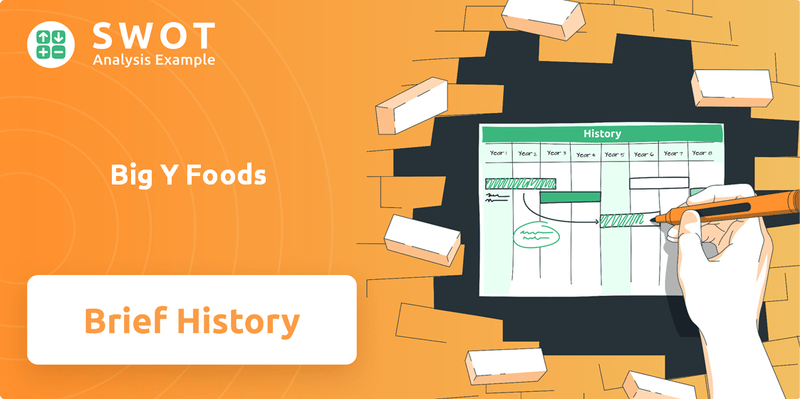
This brief history of Big Y Foods details its remarkable journey from its humble beginnings to its current status as a major player. Explore the Big Y history, including its expansion across Massachusetts and Connecticut, and learn about the key milestones that have shaped the Big Y company. Understand the evolution of Big Y stores and its commitment to providing quality and value.
What is the Big Y Foods Founding Story?
The story of Big Y Foods begins in 1936, a testament to entrepreneurial spirit and family collaboration. Founded by brothers Paul and Gerald D'Amour, the company started with a modest investment and a vision to serve their local community. This early foundation set the stage for the growth and evolution of what would become a significant player in the supermarket industry.
Paul D'Amour, a former bread route salesman, and his brother Gerry, embarked on their venture with a loan and a shared dream. Their initial focus on quality and personalized service laid the groundwork for a customer-centric approach. The company's early years were marked by expansion and innovation, adapting to changing consumer needs and market dynamics.
The Growth Strategy of Big Y Foods has always been rooted in its founding principles.
Big Y Foods, a well-known supermarket chain, was founded in 1936 by brothers Paul and Gerald D'Amour. Paul, at 30 years old, was a bread route salesman who had an entrepreneurial vision. Their initial investment was an $800 loan from family savings.
- The first store, 'Y Cash Market,' was named after a 'Y' intersection in Chicopee, Massachusetts.
- The brothers aimed to provide personal service, quality, and value to the community.
- During World War II, Paul expanded the original store while Gerry was away.
- In 1947, they opened a second, larger store in Chicopee, introducing innovations like frozen foods.
Big Y Foods SWOT Analysis
- Complete SWOT Breakdown
- Fully Customizable
- Editable in Excel & Word
- Professional Formatting
- Investor-Ready Format
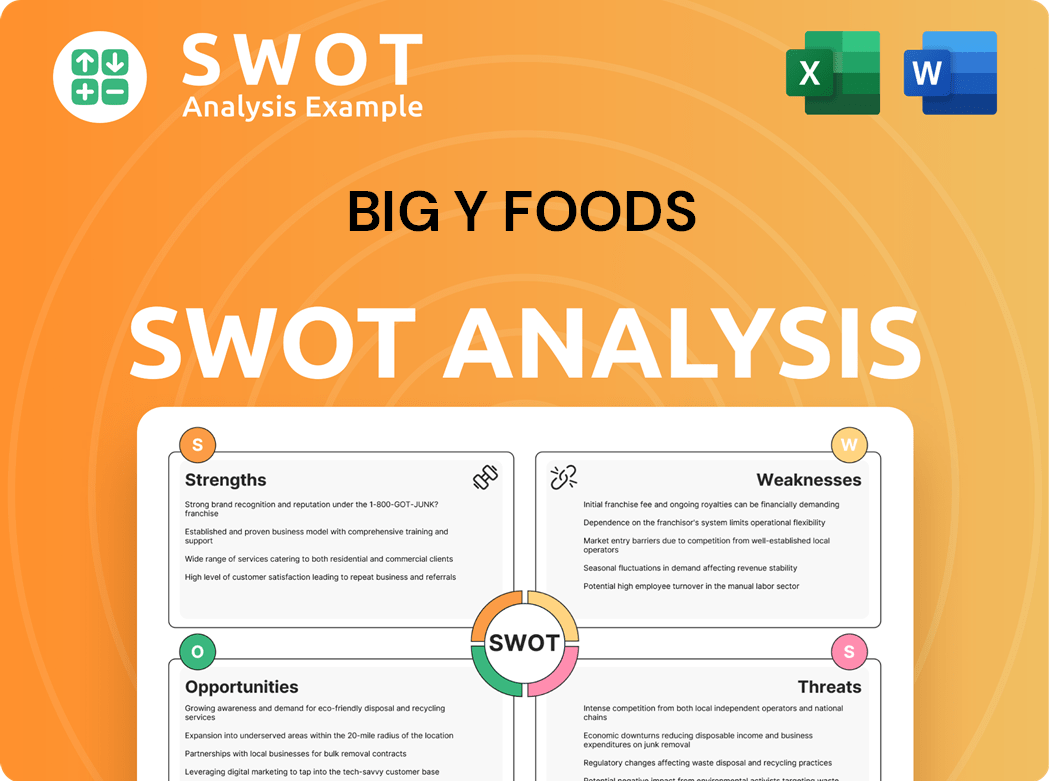
What Drove the Early Growth of Big Y Foods?
The early growth of Big Y Foods was characterized by strategic expansion and the introduction of new retail concepts. The company's journey began with a focus on larger store formats, setting it apart from competitors. This approach facilitated the introduction of diverse product offerings and services, contributing to its early success and establishing its presence in the market.
In 1952, the D'Amour family opened the first Big Y supermarket, a 10,000-square-foot store near Westover Air Force Base in Chicopee. This was significantly larger than other local grocery stores. In 1960, a 31,000-square-foot store was opened in Northampton, becoming the largest supermarket in Western Massachusetts at the time.
Big Y continued to grow, acquiring a second Northampton location in 1963 and establishing Big Y Wines & Liquors. The company moved its operational base to Springfield, Massachusetts, in 1967. A significant acquisition was the seven-store Jumbo Supermarket chain in 1968, bringing the total store count to six.
The 1970s saw continued growth, with the second generation of the D'Amour family joining the company and the introduction of private-label products. In 1984, Big Y expanded into Connecticut by acquiring a supermarket and shopping center in Stafford Springs. The company also purchased the Adams Supermarket chain in Berkshire County, Massachusetts.
By its 50th anniversary in 1986, Big Y had become the top-ranked private grocery chain in western Massachusetts. At that time, it operated 21 stores and employed approximately 1,600 employees, demonstrating significant growth since its founding.
Big Y Foods PESTLE Analysis
- Covers All 6 PESTLE Categories
- No Research Needed – Save Hours of Work
- Built by Experts, Trusted by Consultants
- Instant Download, Ready to Use
- 100% Editable, Fully Customizable
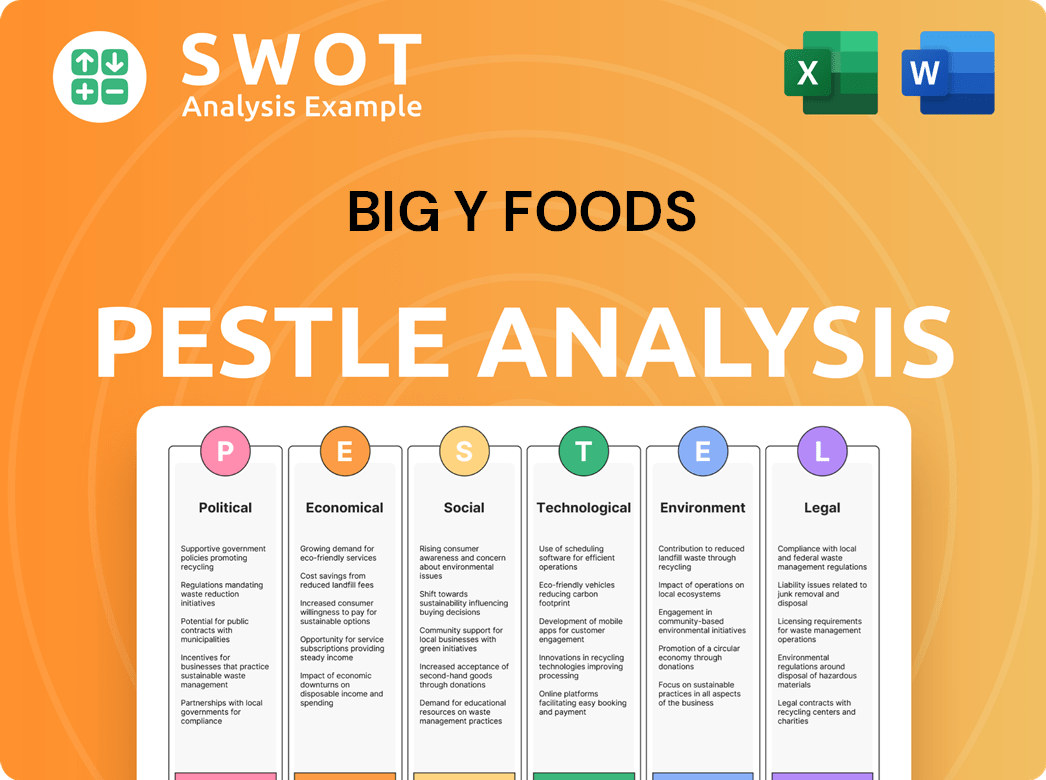
What are the key Milestones in Big Y Foods history?
The Big Y Foods has a rich history marked by significant milestones that have shaped its growth and presence in the supermarket industry. From its early beginnings, the Big Y supermarket has consistently evolved, adapting to market demands and consumer preferences while expanding its footprint across the Northeast.
| Year | Milestone |
|---|---|
| 1990 | Launched the Express Savings Club, enhancing customer loyalty through exclusive savings and benefits. |
| 1993 | Opened its first 'World Class Market' in Springfield, a 64,000-square-foot store emphasizing single-stop shopping. |
| 1993 | Introduced community-service programs like Education Express, Educating Kids, and the Big Y Homework Helpline. |
| 1998 | Launched bigy.com and rebranded Big Y Wines & Liquors into Table & Vine. |
| 2001 | Rolled out a new interactive, computerized register system, showcasing a commitment to technological solutions. |
| 2010 | Purchased seven stores from A&P in central Connecticut, expanding its market presence. |
| 2016 | Acquired eight former Hannaford Big Y stores in Massachusetts, significantly increasing its footprint in Greater Boston. |
| 2021 | Installed a 1.4-megawatt solar array at its Fresh and Local Distribution Center, offsetting about 70% of the center's electricity requirements. |
| 2024 | Acquired the leases of three never-opened Amazon Fresh stores in Connecticut and Massachusetts, demonstrating a strategic pivot. |
Big Y Foods has consistently embraced innovation to enhance the customer experience and operational efficiency. The introduction of bigy.com in 1998 marked its early foray into online services, while the interactive register system in 2001 showed a commitment to technological advancements. These steps, along with the strategic acquisition of locations, have helped Big Y company to adapt to changing consumer behaviors and market dynamics.
The opening of the first 'World Class Market' in 1993, a 64,000-square-foot store, was a significant innovation, emphasizing single-stop shopping and unique amenities.
The launch of bigy.com in 1998 was an early move into online services, allowing customers to interact with the brand digitally.
The introduction of an interactive, computerized register system in 2001 demonstrated a commitment to leveraging technology for improved customer service and operational efficiency.
Acquiring stores from competitors like Hannaford and A&P expanded Big Y locations and market reach.
Installing a 1.4-megawatt solar array at its Fresh and Local Distribution Center in 2021, offsetting about 70% of the center's electricity requirements, and store remodels since 2022 incorporating energy-efficient systems and LED lighting.
Acquiring the leases of three never-opened Amazon Fresh stores in 2024, showcasing a strategic pivot to capitalize on abandoned competitor sites.
Throughout its history, Big Y Foods has faced various challenges, including adapting to a competitive market and responding to operational issues. The company has had to navigate product recalls, such as the May 2025 recall of made-to-order subs, wraps, and paninis due to potential Salmonella contamination. Furthermore, the withdrawal of plans for new stores in Foxborough and Holyoke highlights the need to adjust to changing market conditions and competitive pressures. To get a broader view of the competitive landscape, you can read more in Competitors Landscape of Big Y Foods.
The withdrawal of plans for new stores in certain locations indicates the challenges of navigating a competitive market and adapting to local economic conditions.
Addressing product recalls, such as the May 2025 recall of made-to-order items, is crucial for maintaining consumer trust and ensuring food safety standards.
The need to adapt to changing market conditions and consumer preferences requires continuous operational adjustments and strategic decision-making.
Investing in sustainability efforts, such as the installation of solar panels and energy-efficient store remodels, reflects a commitment to reducing environmental impact and operational costs.
Acquiring abandoned competitor sites demonstrates a strategic agility to capitalize on market opportunities and expand its footprint.
The launch of community-service programs like Education Express, Educating Kids, and the Big Y Homework Helpline demonstrates a commitment to supporting local communities.
Big Y Foods Business Model Canvas
- Complete 9-Block Business Model Canvas
- Effortlessly Communicate Your Business Strategy
- Investor-Ready BMC Format
- 100% Editable and Customizable
- Clear and Structured Layout
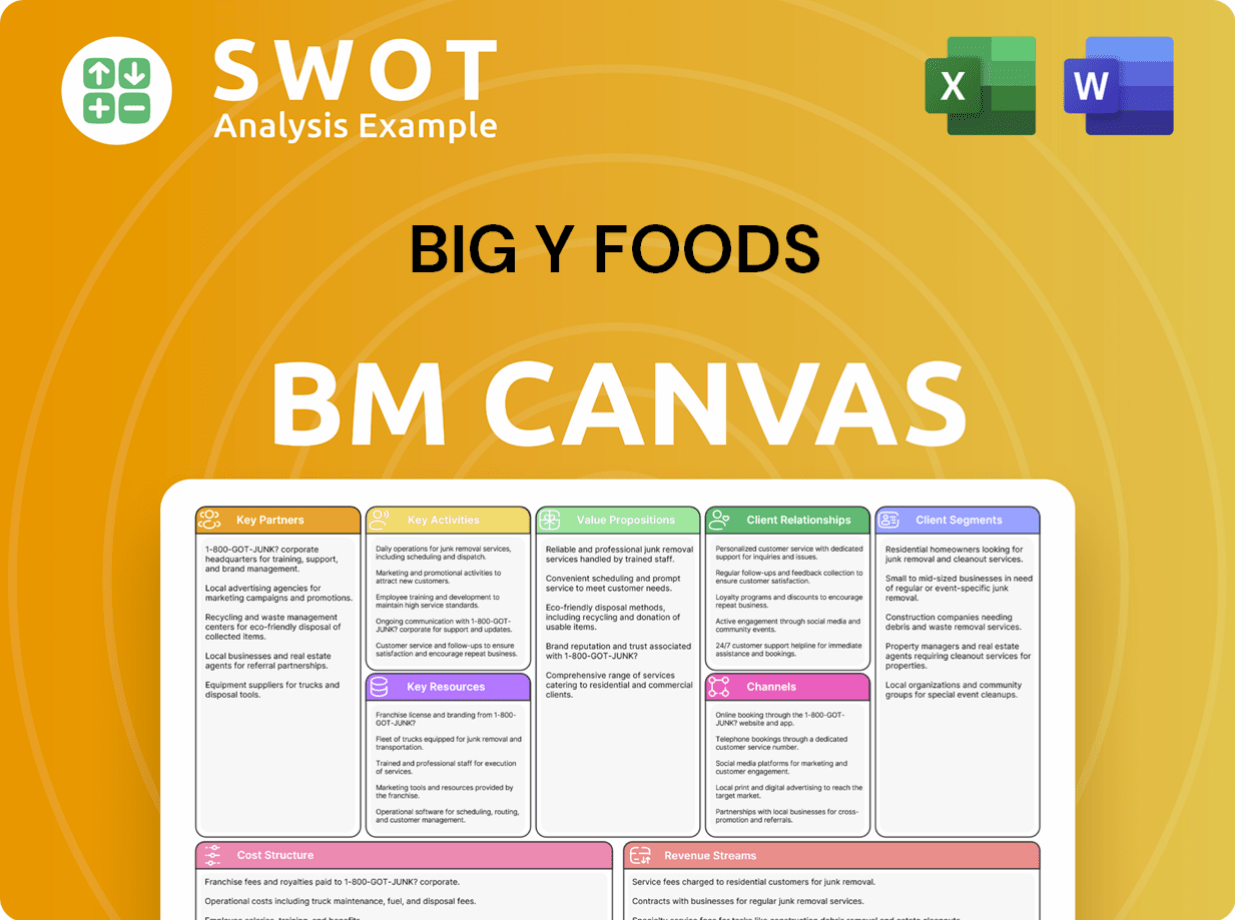
What is the Timeline of Key Events for Big Y Foods?
The story of Big Y Foods began in 1936 when Paul and Gerald D'Amour purchased the Y Cash Market in Chicopee, Massachusetts. This marked the beginning of what would become a significant player in the supermarket industry. Over the years, the company has grown and adapted, expanding its footprint and offerings to meet the evolving needs of its customers.
| Year | Key Event |
|---|---|
| 1936 | Paul and Gerald D'Amour purchased the Y Cash Market in Chicopee, Massachusetts, which laid the foundation for the future Big Y Foods. |
| 1947 | Big Y Foods, Inc. was officially incorporated, and a second Y Cash Market opened, signaling early growth. |
| 1952 | The first Big Y Supermarket opened in Chicopee, representing a shift toward a modern supermarket model. |
| 1960 | A 31,000-square-foot store opened in Northampton, becoming the largest supermarket in Western Massachusetts at the time. |
| 1968 | Big Y acquired the seven-store Jumbo Supermarket chain, expanding its presence. |
| 1984 | The company expanded into Connecticut with an acquisition in Stafford Springs and also acquired the Adams Supermarket chain. |
| 1993 | The first World Class Market opened in Springfield, showcasing a new store concept. |
| 1998 | Bigy.com was launched, and Big Y Wines & Liquors was rebranded as Table & Vine, reflecting a move into online services. |
| 2010 | Big Y purchased seven A&P stores in central Connecticut, increasing its market share. |
| 2013 | The first Big Y Express gas and convenience store opened in Lee, MA, diversifying the company's offerings. |
| 2016 | Big Y acquired eight Hannaford store locations in Massachusetts, further expanding its reach. |
| 2019 | The Fresh and Local Distribution Center expanded to 425,000 square feet, supporting future growth. |
| 2024 (January) | Acquired leasehold interests for three former Amazon Fresh locations in Brookfield, CT, Westport, CT, and Westborough, MA. |
| 2024 (Spring) | The Brookfield, CT store opened, expanding the company's presence in the state. |
| 2024 (Fall) | The Westport, CT store opened, adding another location to the Big Y network. |
| 2024 (November) | Grand reopening of the remodeled Springfield, MA store at 1090 St. James Ave, featuring upgraded décor, expanded fresh foods, and sustainability initiatives. |
| 2025 (January) | Big Y Foods recognized as the National Mango Board's Retailer of the Year, highlighting its commitment to quality. |
| 2025 (February) | Donated 1 million meals to food banks through its annual Sack Hunger campaign, demonstrating community support. |
| 2025 (Summer) | Westborough, MA and Uxbridge, MA stores are expected to open. |
Big Y Foods plans to open new supermarkets in Middletown, CT, and Uxbridge, MA. The company's total number of supermarkets is expected to reach 77 with these new locations, showing continued growth and expansion plans.
The company will continue to emphasize its 'fresh and local' offerings, strengthening partnerships with over 500 local businesses. These partnerships provide more than 4,000 products, supporting the local economy and offering unique choices for customers.
Big Y is committed to sustainability, with ongoing efforts to upgrade stores with energy-efficient equipment. The company is also expanding its use of solar energy, reducing its environmental impact and promoting eco-friendly practices.
Michael P. D'Amour, President and CEO, highlights the company's dedication to community involvement. This includes providing unique fresh and local foods, and supporting local initiatives, reinforcing Big Y's role in the community.
Big Y Foods Porter's Five Forces Analysis
- Covers All 5 Competitive Forces in Detail
- Structured for Consultants, Students, and Founders
- 100% Editable in Microsoft Word & Excel
- Instant Digital Download – Use Immediately
- Compatible with Mac & PC – Fully Unlocked
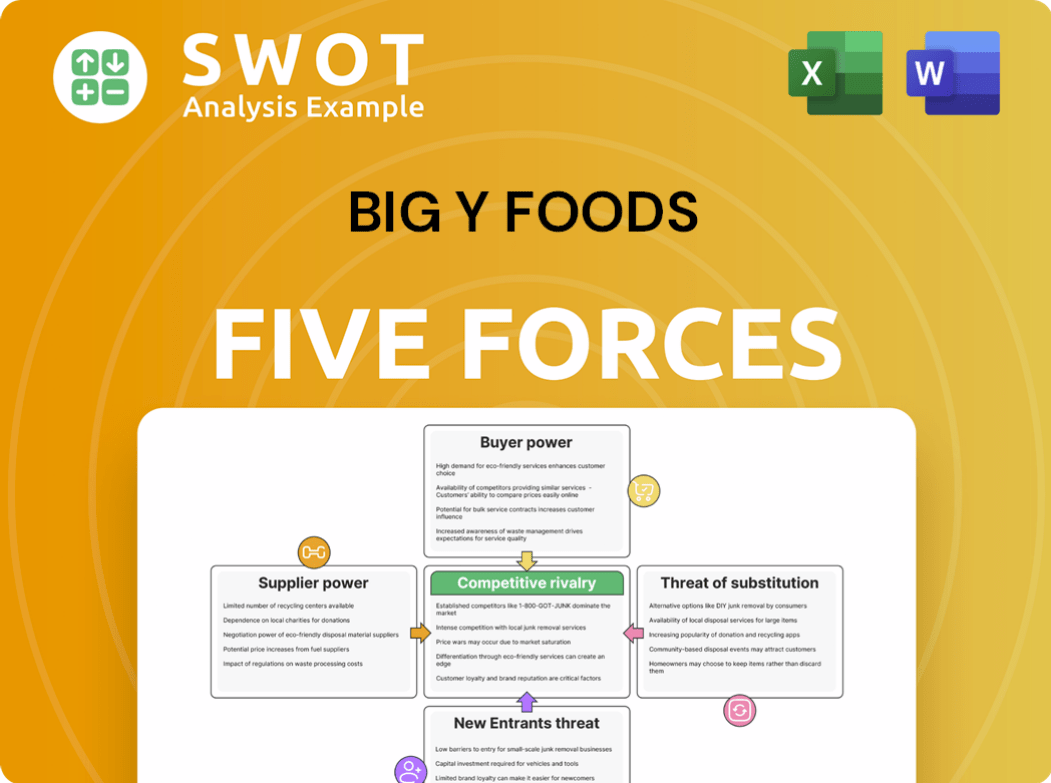
Related Blogs
- What is Competitive Landscape of Big Y Foods Company?
- What is Growth Strategy and Future Prospects of Big Y Foods Company?
- How Does Big Y Foods Company Work?
- What is Sales and Marketing Strategy of Big Y Foods Company?
- What is Brief History of Big Y Foods Company?
- Who Owns Big Y Foods Company?
- What is Customer Demographics and Target Market of Big Y Foods Company?
Disclaimer
All information, articles, and product details provided on this website are for general informational and educational purposes only. We do not claim any ownership over, nor do we intend to infringe upon, any trademarks, copyrights, logos, brand names, or other intellectual property mentioned or depicted on this site. Such intellectual property remains the property of its respective owners, and any references here are made solely for identification or informational purposes, without implying any affiliation, endorsement, or partnership.
We make no representations or warranties, express or implied, regarding the accuracy, completeness, or suitability of any content or products presented. Nothing on this website should be construed as legal, tax, investment, financial, medical, or other professional advice. In addition, no part of this site—including articles or product references—constitutes a solicitation, recommendation, endorsement, advertisement, or offer to buy or sell any securities, franchises, or other financial instruments, particularly in jurisdictions where such activity would be unlawful.
All content is of a general nature and may not address the specific circumstances of any individual or entity. It is not a substitute for professional advice or services. Any actions you take based on the information provided here are strictly at your own risk. You accept full responsibility for any decisions or outcomes arising from your use of this website and agree to release us from any liability in connection with your use of, or reliance upon, the content or products found herein.